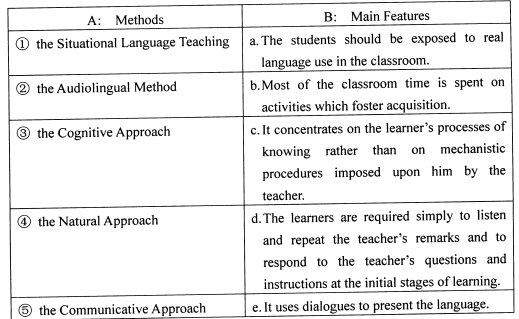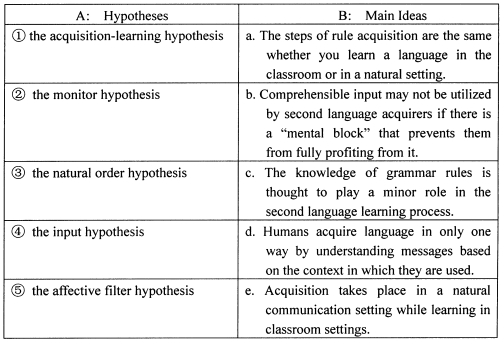欢迎访问桃李自考网,本站可为自考生提供学习指导服务,今天是
欢迎访问桃李自考网,本站可为自考生提供学习指导服务,今天是
I. Mutiple choices: (1%x20 = 20%)
In this section, you are given 20 questions, beneath each of which are four choices marked A, B, C and D. You are to make the best choice and blacken the corresponding letter A, B, C or D on the ANSWER SHEET. One point is given to each correct choice.
1. In 1957, the publication of N. Chomsky's Syntactic Structures started the
A. American structuralism
B. functional linguistics
C. transformational generative linguistics
D. cognitive psychology
2. While he was developing and elaborating the theory of systemic linguistics, M. Halliday made remarkable progress in the study of
A. grammar
B. vocabulary
C. phonetics
D. context
3. Modern experts of foreign language teaching adopted the strategy of combining grammar rules with translation in the.
A.17th century
B.18th century
C.19th century
D.20th century
4. In the mid-19th century,adapted French textbook for use in schools, and thus the Grammar-Translation Method became the principal method of teaching moderm foreign languages.
A. H. Ollendorff
B. J. Seidenstucker
C. K. Ploets
D. G Kelly
5. The Direct Method was developed as a reaction against the
A. Grammar-Translation Method
B. Oral Approach
C. Audiolingual Method
D. Cognitive Approach
6. The syllabus used in the Direct Method is arranged semantically according to
A. grammar
B. topics
C. phonetics
D. vocabulary
7. The 1920s saw the emergence of a new psychology school called
A. Gestalt psychology
B. psychoanalysis
C. behaviorism
D. cognitive psychology
8. In 1904, Jespersen's book,presented a good summary of the Reform Movement's practical implications for the language teachers.
A. How to Teach a Foreign Language
B. The Practical Study of Languages
C. Language Teaching Mus Starl Afresh!
D. Outline of English Phonetics
9. Which of the following is the feature of the Oral Approach?
A. Items of grammar are graded following the principle that simple forms should be taught before complex ones.
B. The rules of grammar should be taught while the students practice the grammar points in context.
C. Grammar should be taught deductively.
D. Reading and writing are introduced before a sufficient lexical and grammatical basis is established.
10. According to H. Palmer, word frequency counts showed that a core of words occurred frequently in daily use and written texts.
A.1000
B.2000
C.3000
D.4000
11.The general objective of the Audiolingual Method is to enable the students to use the target language
A. fluently
B. communicatively
C. properly
D. accurately
12. Structural linguists hold that are the basis of language and the center of foreign language teaching.
A. drills .
B. dialogues
C. sentence patterns
D. speeches
13. Which of the following statements is true about J. Piaget?
A. Piaget saw cognitive development as esentially a process of maturation, within which genetics and experience disconnect.
B. Piaget referred the schemata theory to the mental framework of future expectation.
C. Thought or thinking has its origin in actions physically performed and then internalized.
D. In the early 1960s, the famous French psychologist Piaget established his theory of cognitive development.
14.emphasizes active restructuring of knowledge through experience with the environment.
A. J. Bruner
B. J. Piaget
C. A. Ausubel
D. G. Kelly
15. The Total Physical Response Method holds that most of the grammatical structures of target language can be learned from the slilful use of the by the teacher.
A. paralanguage
B. question
C. body movement
D. imperative
16. The Silent Way takes a approach to the organization of the language to be taught.
A. functional
B. structural
C. communicative
D. lexical
17.takes its principle from the more general counseling-learming approach developed by C. Curran.
A. The Silent Way
B. Suggestopaedia
C. Community Language Learning
D. The Total Physical Response
18. The Oral Approach was the accepted British approach to English language teaching by the.
A.1930's
B.1940's
C.1950's
D.1960's
19. In terms of language theory, there existed difference between the Oral Approach and the Audiolingualism.
A. absolutely no
B. lttle
C. much
D. very much
20. The Cognitive Approach developed as an altenative, in response to the cricisms leveled against
A. audiolingualism
B. mentalism
C. the Communicative Approach
D. the Direct Method
II. Flling Blanks: (1%x20 = 20%)
In this section, there are 20 statements with 20 blanks. You are to fill each blank with ONE appropriate word on the ANSWER SHEET. One point is given to each blank.
21. In the fifth century B.C. the argued that the forms of words reflected directly the nature of objects.
22. Linguistic competence refers to the knowledge of the language that a native speaker of that language possesses.
23. In the Grammar-Translation Method casroom, the teacher seldom uses the, language as the main medium of instruction.
24. Viewed from the nature and purpose of education, the Grammar-Translation Method was an expression of classical
25. At the end of the 1960s,began to descend from its dominant position, which was to be taken by a new approach called cognitive psychology.
26. In the Direct Method, the general goal of a language programme is to teach skills.
27. Acording to Comenius, the best method is not to make the learmer learn the rules themselves, but to provide direct practice in speaking and listening through and repetition.
28. In presenting the language structure, the Oral Approach emphasies the function of which can help learners to apply what they have learned into real-life practice.
29. The Situational Language Teaching's aempts to etalish theoretical principles to develop a methodological framework for teaching English as a foreign language mark the beginning of the discipline of_____linguistics.
30. Politzer summarized Skinner's view in his famous quotation“language is.
31. According to the behaviorist, once the habit is established, the subject will continue to respond correctly to the stimulus, even if the. is not present.
32. Transormational-generative linguistic theory points out that apparent simiarity of surface forms of a language in dfferent utterances may cover up important dfferences in 33. It is this “_”一knowledge of grammar rules which allows a native
speaker to make sentences in his language, although he might not know all the rules of a grammar.
34. Though they claim language is a vehicle for communicating meaning, Terrell and Krashen view language learning as mastery of by stages.
35. From the beginning of a class taught according to the Natural Approach, emphasis is on presenting input in the target language.
36. By the late 1960s, some theoretical linguists had become conscious of the fact that in linguistic research meaning and were neglected.
37. The functionalists considered the purpose language serves in normal interaction to be basic to the determination of functions.
38. Van Ek and Alexander list some 70 different language functions, around which are organized.
39. The Total Physical Response Method emphasizes the use of physical action to teach a foreign language at an level.
40. In the Silent Way class, language is taught through artificial situations, usually represented by.
II. Matching: (1%x10 = 10%)
This section consists of two groups of pairs listed in two columns, A and B. You are to match the one marked①,②,③,④, or⑤in Column A with the one marked a, b,c, d, or e in Column B. One point is given to each pair you match correctly. Your answers should be written on the ANSWER SHEET.
41.
42.
IV. Questions for Brief Answers in English: (5%x6 = 30%)
In this section there are questions which you are required to answer briefly on the ANSWER SHEET. Five points are given to each question.
43. What are the four aspects emphasized by the grammatical rules in the Grammar-Translation Method?
44. What are the guidelines for classroom practice with the application of the Natural Approach?
45. What are the procedures employed in the Direct Method?
46. What are the five distinctive characteristics formed in the Audiolingual Method?
47. What are advance organizers according to Ausubel?
48. What are the objectives of the Oral Approach?
V. Questions for Long Answers in English: (10%x2 = 20%)
The two questions in this section are to be answered on the basis of your own teaching experience as well as the theoretical knowledge you've learned. Ten points are given to each question. Your answers should be written on the ANSWER SHEET.
49. What implications for foreign language teaching do you see in Chomsky' s work?
50. What are the four dimensions of communicative competence according to Canale and Swain (1980)?
热点推荐: